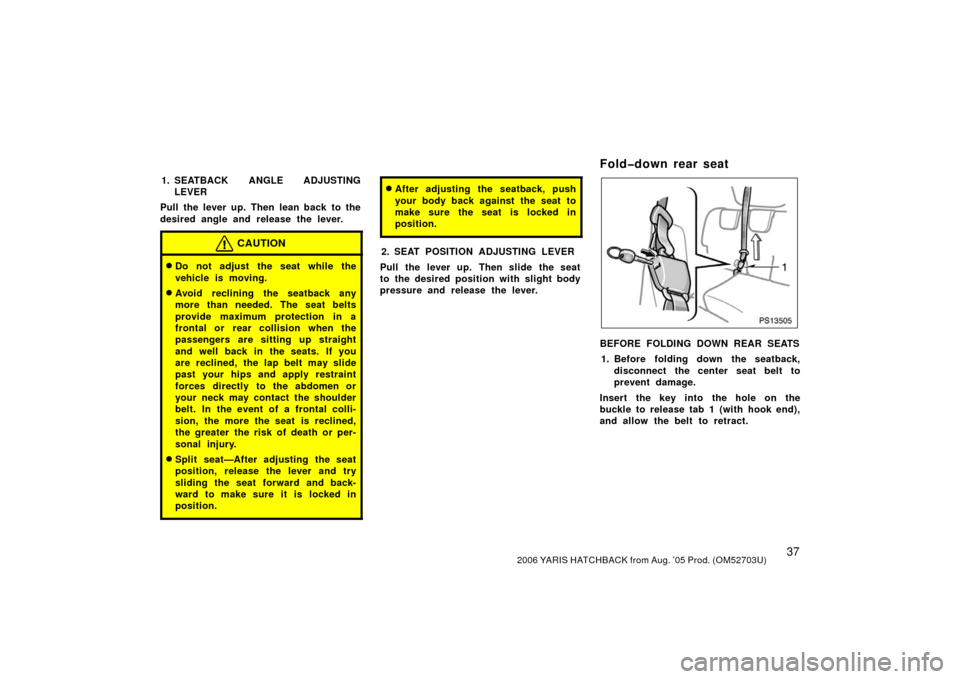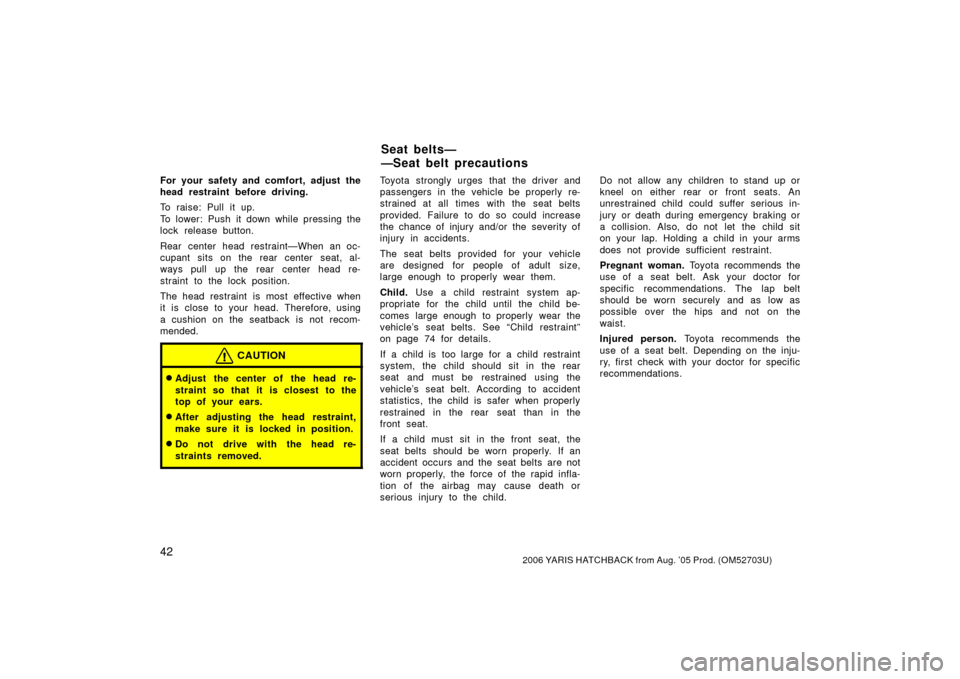Page 39 of 312

322006 YARIS HATCHBACK from Aug. ’05 Prod. (OM52703U)
Seats
While the vehicle is being driven, all ve-
hicle occupants should have the seatback
upright, sit well back in the seat and prop-
erly wear the seat belts provided.
CAUTION
�Do not drive the vehicle unless the
occupants are properly seated. Do
not allow any passengers to sit on
top of a folded�down seatback, or
in the luggage compartment or car-
go area. Persons not properly
seated and/or not properly re-
strained by seat belts can be se-
verely injured in the event of emer-
gency braking or a collision.
�During driving, do not allow any
passengers to stand up or move
around between seats. Otherwise,
severe injuries can occur in the
event of emergency braking or a
collision.
Driver seat
CAUTION
The SRS driver airbag deploys with
considerable force, and can cause
death or serious injury especially if
the driver is very close to the airbag.
The National Highway Traffic Safety
Administration (“NHTSA”) advises:
Since the risk zone for driver airbag
is the first 50—75 mm (2—3 in.) of
inflation, placing yourself 250 mm (10
in.) from your driver airbag provides
you with a clear margin of safety.
This distance is measured from the
center of the steering wheel to your
breastbone. If you sit less than 250
mm (10 in.) away now, you can
change your driving position in sever-
al ways:
�Move your seat to the rear as far
as you can while still reaching the
pedals comfortably.
�Slightly recline the back of the
seat. Although vehicle designs vary,
many drivers can achieve the 250
mm (10 in.) distance, even with the
driver seat all the way forward, sim-
ply by reclining the back of the
seat somewhat. If reclining the back
of your seat makes it hard to see
the road, raise yourself by using a
firm, non�slippery cushion, or raise
the seat if your vehicle has that
feature.
�If your steering wheel is adjustable,
tilt it downward. This points the air-
bag toward your chest instead of
your head and neck.
The seat should be adjusted as rec-
ommended by NHTSA above, while
still maintaining control of the foot
pedals, steering wheel, and your view
of the instrument panel controls.
Front seats—
—Front seat precautions
Page 42 of 312

352006 YARIS HATCHBACK from Aug. ’05 Prod. (OM52703U)
CAUTION
Avoid reclining the seatback any
more than needed. The seat belts pro-
vide maximum protection in a frontal
or rear collision when the driver and
the front passenger are sitting up
straight and well back in the seats. If
you are reclined, the lap belt may
slide past your hips and apply re-
straint forces directly to the abdomen
or your neck may contact the shoul-
der belt. In the event of a frontal
collision, the more the seat is re-
clined, the greater the risk of death
or personal injury.
PS13502
For easy access to the rear seat:1. Lift up the seatback lock release lever.
The seat will slide forward.
2. Move the seat to the front −most posi-
tion.
After rear passengers are in, lift up the
seatback and return the seat until it locks.
CAUTION
After putting back the seat, try push-
ing the seat forward and rearward to
make sure it is secured in place.
CAUTION
�Do not adjust the seat while the
vehicle is moving.
�Be careful that the seat does not
hit a passenger or luggage.
�Be careful not to get your hands or
feet pinched in the seat.
�Split seat—After adjusting the seat
position, release the lever and try
sliding the seat forward and back-
ward to make sure it is locked in
position.
�After adjusting the seatback, push
your body back against the seat to
make sure the seat is locked in
position.
�When returning the seatback to the
upright position, observe the follow-
ing precautions in order to prevent
personal injury in a collision or
sudden stop:
Make sure the seatback is securely
locked by pushing forward and rear-
ward on the top of the seatback.
Failure to do so will prevent the
seat belt from operating properly.
—Moving passenger ’s seat for
rear seat entry
(3�door models only) Rear seats—
—Rear seat precautions
Page 43 of 312
362006 YARIS HATCHBACK from Aug. ’05 Prod. (OM52703U)
Make sure the seat belts are not
twisted or caught in the seatback
and are arranged in their proper
position and are ready to use.
Folding down the rear seatbacks will en-
large the luggage compartment. See
“—Stowage precautions” on page 202 in
Section 2 for precautions when loading
luggage.
—Adjusting rear seats
PS13503
Split seat
PS13504
Non�split seat
Page 44 of 312

372006 YARIS HATCHBACK from Aug. ’05 Prod. (OM52703U)
1. SEATBACK ANGLE ADJUSTINGLEVER
Pull the lever up. Then lean back to the
desired angle and release the lever.
CAUTION
�Do not adjust the seat while the
vehicle is moving.
�Avoid reclining the seatback any
more than needed. The seat belts
provide maximum protection in a
frontal or rear collision when the
passengers are sitting up straight
and well back in the seats. If you
are reclined, the lap belt may slide
past your hips and apply restraint
forces directly to the abdomen or
your neck may contact the shoulder
belt. In the event of a frontal colli-
sion, the more the seat is reclined,
the greater the risk of death or per-
sonal injury.
�Split seat—After adjusting the seat
position, release the lever and try
sliding the seat forward and back-
ward to make sure it is locked in
position.
�After adjusting the seatback, push
your body back against the seat to
make sure the seat is locked in
position.
2. SEAT POSITION ADJUSTING LEVER
Pull the lever up. Then slide the seat
to the desired position with slight body
pressure and release the lever.
Fold�down rear seat
PS13505
BEFORE FOLDING DOWN REAR SEATS 1. Before folding down the seatback, disconnect the center seat belt to
prevent damage.
Insert the key into the hole on the
buckle to release tab 1 (with hook end),
and allow the belt to retract.
Page 45 of 312
382006 YARIS HATCHBACK from Aug. ’05 Prod. (OM52703U)
PS13049
2. Insert the tabs of the center seatbelt into the cover. Make sure the
tabs are securely locked in the cov-
er.
NOTICE
The seat belt tabs must be stowed
before you fold the seatback.
PS13506
3. Make sure the outer seat belt passesthrough the hanger when folding the
seatback down.
This prevents the shoulder belt from being
damaged.
CAUTION
The seat belt must be removed from
the hanger when the seat belt is in
use.
NOTICE
The seat belt must be stowed before
you fold the seatback.
PS13507
FOLDING REAR SEATS (split seat)
1. Lower the head restraint to the low- est position.
Page 46 of 312
392006 YARIS HATCHBACK from Aug. ’05 Prod. (OM52703U)
PS13508
2. Pull the seat position adjusting liverup. Then slide the rear seat fully
forward.
PS13509
3. Pull the seatback angle adjusting le-ver up and fold the seatback down.
Each seatback may be folded separately.
CAUTION
When returning the seatback to the
upright position, observe the follow-
ing precautions in order to prevent
personal injury in a collision or sud-
den stop:
�Make sure the seatback is securely
locked by pushing forward and rear-
ward on the top of the seatback.
Failure to do so will prevent the
seat belt from operating properly.
�Make sure the seat belts are not
twisted or caught in the seatback
and are arranged in the proper
position and are ready to use.
NOTICE
Do not pull the pocket that stores the
seat belt comfort guide when return-
ing the seatback to the upright posi-
tion.
Page 48 of 312
412006 YARIS HATCHBACK from Aug. ’05 Prod. (OM52703U)
CAUTION
When returning the seatback to the
upright position, observe the follow-
ing precautions in order to prevent
personal injury in a collision or sud-
den stop:
�Make sure the seatback is securely
locked by pushing forward and rear-
ward on the top of the seatback.
Failure to do so will prevent the
seat belt from operating properly.
�Make sure the seat belts are not
twisted or caught in the seatback
and are arranged in the proper
position and are ready to use.
NOTICE
Do not pull the pocket that stores the
seat belt comfort guide when return-
ing the seatback to the upright posi-
tion.
Head restraints
PS13513
Front seat
PS13514
Rear seat (split seat)
PS13515
Rear seat (non�split seat)
Page 49 of 312

422006 YARIS HATCHBACK from Aug. ’05 Prod. (OM52703U)
For your safety and comfort, adjust the
head restraint before driving.
To raise: Pull it up.
To lower: Push it down while pressing the
lock release button.
Rear center head restraint—When an oc-
cupant sits on the rear center seat, al-
ways pull up the rear center head re-
straint to the lock position.
The head restraint is most effective when
it is close to your head. Therefore, using
a cushion on the seatback is not recom-
mended.
CAUTION
�Adjust the center of the head re-
straint so that it is closest to the
top of your ears.
�After adjusting the head restraint,
make sure it is locked in position.
�Do not drive with the head re-
straints removed.
Toyota strongly urges that the driver and
passengers in the vehicle be properly re-
strained at all times with the seat belts
provided. Failure to do so could increase
the chance of injury and/or the severity of
injury in accidents.
The seat belts provided for your vehicle
are designed for people of adult size,
large enough to properly wear them.
Child. Use a child restraint system ap-
propriate for the child until the child be-
comes large enough to properly wear the
vehicle’s seat belts. See “Child restraint”
on page 74 for details.
If a child is too large for a child restraint
system, the child s hould sit in the rear
seat and must be restrained using the
vehicle’s seat belt. According to accident
statistics, the child is safer when properly
restrained in the rear seat than in the
front seat.
If a child must sit in the front seat, the
seat belts should be worn properly. If an
accident occurs and the seat belts are not
worn properly, the force of the rapid infla-
tion of the airbag may cause death or
serious injury to the child. Do not allow any children to stand up or
kneel on either rear or front seats. An
unrestrained child could suffer serious in-
jury or death during emergency braking or
a collision. Also, do not let the child sit
on your lap. Holding a child in your arms
does not provide sufficient restraint.
Pregnant woman.
Toyota recommends the
use of a seat belt. Ask your doctor for
specific recommendations. The lap belt
should be worn securely and as low as
possible over the hips and not on the
waist.
Injured person. Toyota recommends the
use of a seat belt. Depending on the inju-
ry, first check with your doctor for specific
recommendations.
Seat belts—
—Seat belt precautions